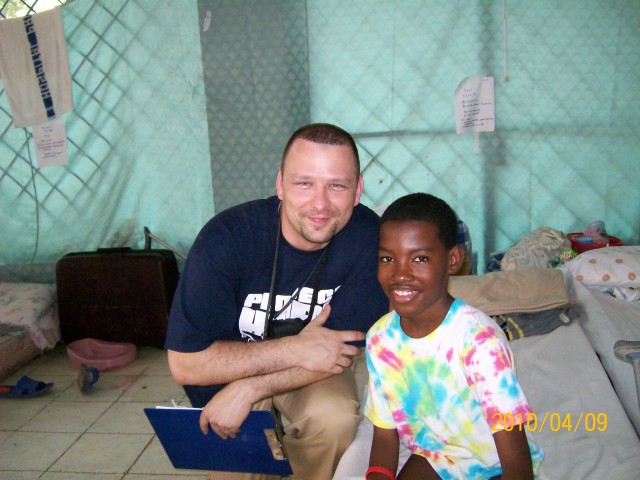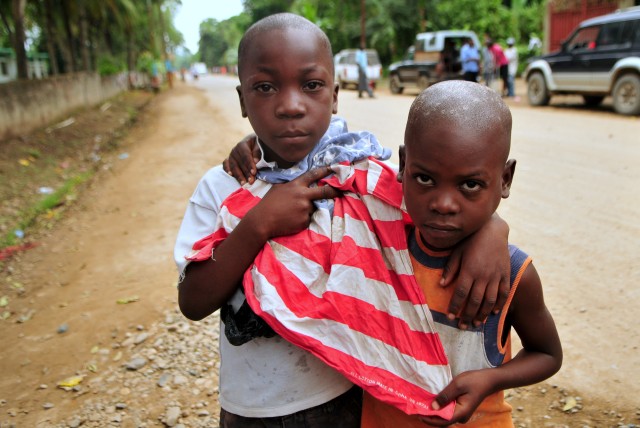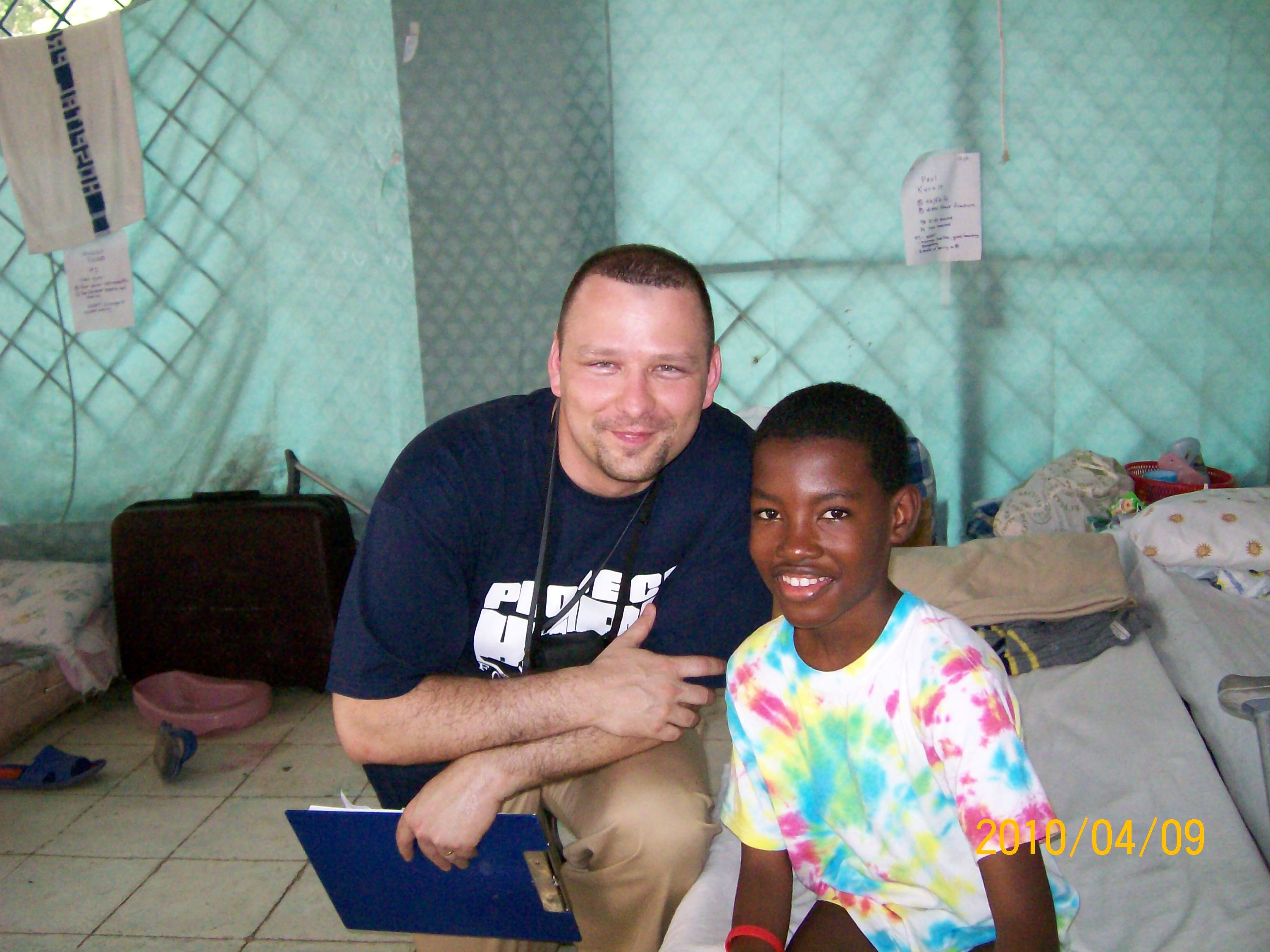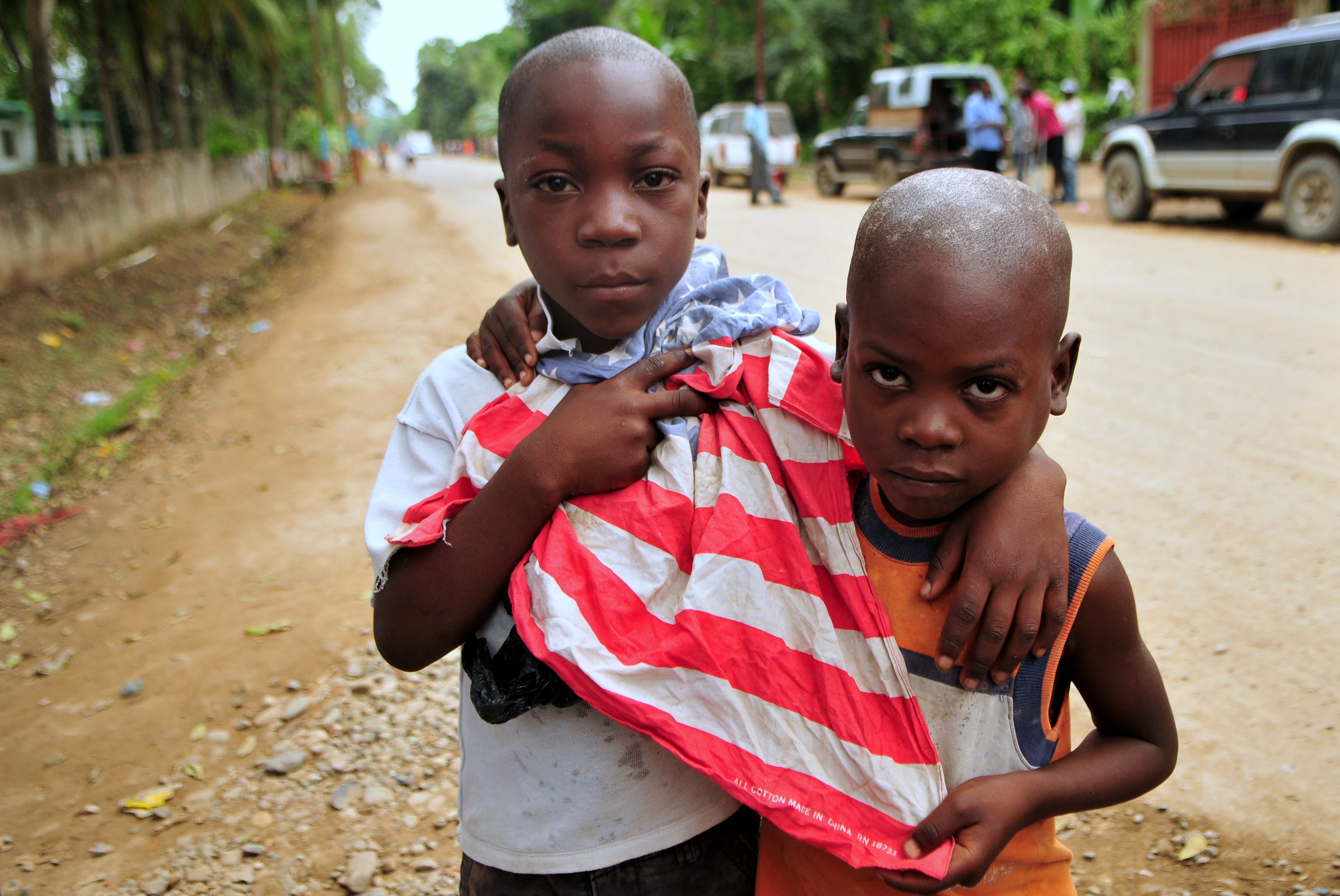When the equipment fails, the lights go out and all seems lost, USAMMA's Technology Assessment and Requirements Analysis team provides the logistical know-how to put medical facilities back on track.
"Today is a blur for me," says Terry Dover, Chief Warrant Officer 3, fresh from temporary duty. "I walked into my office over there, and I said, 'Where's all my stuff' Did I get fired while I was gone''"
Thankfully, it was just another move. His papers and belongings lie boxed in a new office. A framed photo of his smiling family sits on the unfamiliar desk. A carved Polynesian mask from a trip to Hawaii glares from the wall with an open-mouthed scowl, bemoaning its latest excursion in cardboard.
Dover himself is used to being on the go. He and colleagues on the Technology Assessment and Requirements Analysis (TARA) team have experienced steady growth and inevitable changes over the past few years. Dover is Project Manager for Clinical Technologies and the TARA Team Lead, Integrated Clinical Systems PMO.
TARA falls under the U.S. Medical Materiel Agency (USAMMA), a key component of the U.S. Army Medical Research and Materiel Command. USAMMA manages strategic-level medical logistics and provides medical equipment for Active Component, Army Reserve and National Guard forces. Comprising a full-time team of 14 and drawing on a corps of expert consultants from the Office of the Surgeon General, the TARA team conducts thorough analyses of medical treatment facilities. It assesses clinical operations; workload requirements; technical operations; and equipment maintenance, use and life cycle. TARA translates those findings into recommended process improvements and equipment replacement plans. Since 1995 the program has a recognized cost savings or avoidance of $231 million for the Army Medical Department in service and maintenance contracts, equipment purchases, group buys and environmental hazard reduction.
No wonder TARA is in demand -- and on call around the clock.
"Because of the time zone difference," Dover says, "there is work 24/7.
"Now we're doing all the COCOM [Combatant Command], or trying to," he continues. "We just picked up SOUTHCOM [Southern Command] this last year. We've been working with CENTCOM [Central Command] since 2008. We expect AFRICOM [Africa Command] to come on board in the next few years based on what we see happening there."
Dover's team charts an ambitious schedule. It is slated to assess at least seven Army Medical Centers and Hospitals this year alone. By year's end the TARA team will have zigzagged across the country from Maryland to Kentucky, Texas, Georgia, Washington, Alaska and California. In past years the team has deployed to such far-flung locales as Korea, Kuwait, Afghanistan, Iraq and Honduras.
But TARA isn't just going in circles. The team has made vital changes to outdated doctrine at medical treatment facilities worldwide. Dover cites the increased use of and reliance on CT scans as a prime example.
"CTs were not the standard," he says. "But if you look at how and when that doctrine was written, it is very dated. We changed things dramatically when we went into the Gulf War, but even more so with our current conflicts. The CT became essential [toward assessing] the types of trauma we are seeing now.
"When you have a person who is unconscious or with a blast injury, you cannot really diagnose internally what is going on," Dover explains. "With a CT you can see everything to some degree, and you can perform a CT scan in a couple of minutes -- know what is broken, what is not broken, where things may be bleeding or not bleeding. That becomes critical when you go into surgery."
Dover and his team understand that CT's benefit extends beyond the operating room, as the resulting scans provide important feedback to field combat units.
"If we see certain head injuries on a CT," he says, "we know the armor is not doing the job. Or, maybe it's doing the job but missing this part of it. So people are going to go back and say, 'Look, we know blast injuries are doing this. We are protecting the skull, but we have all these other problems.'"
CT is just one tool in TARA's growing arsenal. Dover's overriding mission is to assemble joint teams to better understand how different forces' facilities might operate.
"The intent is to pool [experts] from different areas," Dover says, "so when we walk through the doors [of any] facility, that gives us instant credibility. There are some nuances how the Army does things, how the Air Force does things and how the Navy does things, but ultimately how they treat patients is really the same. It is just getting through the operational piece and figuring that out."
Col. Kelly Wolgast has worked in every capacity imaginable -- as a team member and TARA recipient, in addition to being Commander of Evans Army Community Hospital at Fort Carson, Colorado. She bears out the team's reliance on authoritative consultants.
"When you have a radiologist speaking to radiology people about radiology things," says Wolgast, "those conversations tend to go very quickly, because everybody understands each other. When I speak about clinical systems and nursing care, well, as the Senior Nurse Executive in the U.S. Army Medical Command, that's my role and responsibility, and I am perceived as an expert in that, so that's a good thing. You're already over the credibility hump."
For those facing new assignments, a TARA assessment can outline a facility's capabilities, enabling incoming personnel to quickly get up to speed. Last winter the team traveled to Soto Cano Air Base in Comayagua, Honduras, to evaluate the medical element at Joint Task Force-Bravo (JTF-B) in advance of a new logistics chief. What the team found was a facility in need of logistical guidance. JTF-B is wholly dependent on generators for its power. The climate is hot and humid, with rain half the year -- conditions hard on equipment. In lieu of local support, base personnel must send the equipment stateside for maintenance. And if a crisis occurs, humanitarian or otherwise, staff must pull field equipment from the clinic.
In just one week Dover and 10 team members combed through JTF-B, evaluating the facility's nursing and operations, its equipment and laboratory, its diagnostic imaging, and its image archival and transferal system. The resulting report included an eight-page inventory of more than 150 items, from operating tables to defibrillators to battery chargers, listing manufacturers, model numbers, life expectancy and replacement dates for each piece of equipment. This list will serve as a replacement and acquisition plan.
TARA also streamlined the cumbersome equipment replacement process and made specific recommendations in other areas, from training to staffing to record-keeping, all with an eye on improving safe operations and the quality of care.
U.S. Air Force Maj. Andrea Ryan, the incoming Logistics Chief, reported to JTF-B four months after the assessment but had plenty of praise for what Dover's team was able to achieve in its short time at the facility.
"Chief Dover has been nothing short of amazing," says Ryan. "The TARA team was able to assess the equipment and put together a replacement schedule, ensuring that critical medical equipment used in delivering health care to our deployed members is the best it can be and within safety and regulatory management controls.
"[That] support for field operations is more than any medical logistics officer could ask for."
TARA is working as fast as it can to meet the growing demand.
"The demand is pretty high," Wolgast admits, "but we can only do so many a year. So we look at the schedule and focus on places that emerge as high need -- for instance, a place that had a natural disaster [see sidebar, "Natural Disaster, Manmade Solutions"] or some sort of facility failure. We could do a visit like that."
Dover keeps his suitcase and rucksack handy, just in case.
For more information on the TARA program, visit http://www.usamma.army.mil/tara.cfm.
Natural Disaster, Manmade Solutions
On Jan. 12, 2010, a 7.0-magnitude earthquake struck near Port-Au-Prince, Haiti, killing as many as 300,000, injuring another 300,000 and leaving 1 million homeless. In the wake of the disaster, Project HOPE sent doctors, nurses, technicians and medical supplies to Haiti aboard USNS Comfort. Leading the medical response team was Col. Fred Gerber (U.S. Army, Ret.), Project HOPE Country Director for Iraq and Special Projects.
In March, Gerber turned his attention to three timeworn hospitals: the 70-bed Adventist in Diquini, Port-Au-Prince; the 130-bed Albert Schweitzer in Deschapelles; and the 73-bed Sacred Heart in Milot. All were overwhelmed, their caseloads tripling in a matter of days, taxing their sanitation infrastructure and electrical capacity. And each faced dire shortages of medicine, oxygen and potable water.
Where others might see futility, Gerber saw opportunity, drawing on his longtime tenure as a medical planner and operator for the U.S. Army Medical Department.
"It was a perfect opportunity to do a health facilities assessment to identify the gaps," he explains. "I did it in the military with the Health Facilities Planning Agency [HFPA]. They would put teams together -- mechanical and electrical engineers, architects, health facilities planners ... nurse critical assessors and medical equipment, repairmen, technicians from USAMMA. And so that's what we did."
With himself as lead, Gerber put together a six-member assessment team, including a health/facility planner, an electrical engineer, a mechanical engineer and a structural engineer. TARA Lead Terry Dover filled the sixth slot as the team's biomedical equipment specialist.
"I went as a Project HOPE member," Dover says, "using my TARA and HFPA background, that process, and applying it to what we knew."
The team wasted no time, assessing Albert Schweitzer on April 7, Sacred Heart on April 9 and Adventist on April 11, inspecting each facility from top to bottom. Dover inventoried all usable medical equipment as well as defunct gear to determine whether it was repairable. Gerber knit together Dover's assessment with those of the other members to provide each facility with not just short-term fixes but broad, long-term solutions.
"We looked at several hospitals," Dover explains, "[but] really laid out a plan to rebuild the entire medical infrastructure."
Tim Traynor of the CRUDEM Foundation, Facility Director at Sacred Heart, was particularly impressed by the team's assessment of his hospital's electrical system, marked by exposed wires that would actually short out and catch fire during surgeries.
"[The lack of] reliable electricity in Haiti is the bane of progress," Traynor explains. "The timing was perfect, because [our systems] were under the greatest amount of physical strain and stress, and there were opportunities to take measurements and make observations unique to such stress."
The team presented Traynor with a plan to rewire the entire electrical system and soon acquired all the necessary wire, panels and other parts.
The plan also addressed other problem areas, from patient capacity to air filtration and adequate roofing. Its assessment was respectfully candid about infrastructure realities in the beleaguered island nation, stating in part, "Some of what appear to be problems become less significant as the evaluators become more familiar and accepting with the realities and expectations of the Haitian people."
"The core value of the document lies in the fact it was integrated from multiple disciplines," Traynor says. "Things were not taken in a vacuum -- they were looked at in the greatest overall picture. I was very surprised at the quality. For a group that basically went in and was very intuitive, they walked out with a picture that took me probably two and a half years to put together in my mind. They did it in a couple weeks, and that's impressive, very impressive."
January marked a year since the earthquake. Even before it struck, life in Haiti was rough going. The hospitals were rationing power, and the quake further taxed their electrical systems. Now the country is reeling from political upheaval while fighting a deadly cholera outbreak; Sacred Heart alone treated more than 1,000 cholera patients in November and December. And while funds have been pledged, they have been slow to arrive.
Traynor stands in the gap at Sacred Heart and remains unperturbed. "It is important we keep our heads and continue to make plans and progress in the face of all these other obstacles, and I think that's the greatest contribution these guys made. They were in a chaotic environment, they did perform a very valuable function, and they've all said whatever they can do to help, they'd like to continue. [They deserve] a lot of gratitude for that."
A Gift from Heaven
By Tim Traynor, Sacred Heart Hospital, Milot, Haiti
The boy at left in the above photo was standing on the outskirts of a crowd just outside our triage area at Sacred Heart Hospital in Milot. I noticed he had something stuffed under his shirt. We had just brought in a couple of badly injured children, and their cries drew the crowd closer. The boy was looking on with concern when I approached and asked what he had beneath his shirt. Tugging free a small American flag, the boy draped it over his shoulder and said in halting English, "This is my flag." I asked where he had gotten it, and he replied that a "flying man" had given it to him.
As the boy continued his story in Creole, a Haitian friend of mine stood by to translate.
The boy had been standing in the corner of a soccer field turned airfield, watching the medical transports take off and land, when one of the pilots passed by, headed back to his helicopter. Noticing the boy, the pilot reached into his flight jacket and retrieved the small banner. The exchange was quick, as the pilot boarded his chopper and in a minute was gone in a swirl of dust and noise.
I asked the boy if he knew where America was, and he said it was near heaven.
That choked me up, but I kept my composure and asked if I could take his photo. He consented. Amid the tall and shifting crowd, this little man again spread the flag over his shoulder. In an instant, an even smaller boy leaned into my viewfinder, took a corner of the flag and stared back at me with a look that said he was essential to my photo. I snapped four, maybe five shots before the boy with the flag melted back into the crowd, quickly rolling up his treasure and stuffing it safely back under his shirt.
When I returned to the compound well after dark and downloaded my photos from the day, I found the one of the two boys and our flag staring back at me with the words "America is near heaven" echoing in my heart. The image of angels descending from a place where life was good to save these damaged souls caught me open, vulnerable, and the tears flowed.
During those days of stress, uncertainty and desperate vigilance, the image of that boy remained most poignant to me, as in just a few words he summed up my reason for being there. It was my privilege to do all I could to help save lives and reduce the suffering of the Haitian people.




Social Sharing